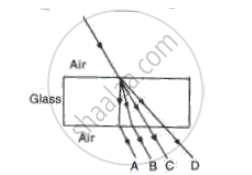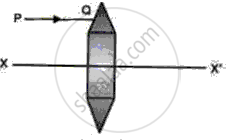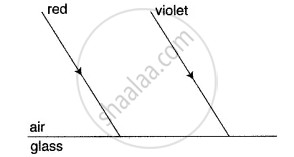Advertisements
Advertisements
Question
Draw a ray diagram to show the refraction of a monochromatic ray through a prism when it suffers minimum deviation
Solution
Refraction of a monochromatic ray through a prism when it goes through minimum deviation:

APPEARS IN
RELATED QUESTIONS
A ray of light enters a glass slab ABDC as shown in figure and strikes at the centre O of the circular part AC of the slab. The critical angle of glass is 42°. Complete the path of the ray till it emerges out from the slab. Mark the angles in the diagram wherever necessary.

In the fig. name the ray which represents the correct path of light while passing through a glass block.

Fig shows a lens as a combination of a glass block and two prisms.

(i) Name the lens formed by the combination.
(ii) what is the XX' called?
(iii) Complete the ray diagram and show the path of the incident ray PQ after passing through the lens.
(iv) The final emergent ray will either meet XX' at a point or appear to come from a point on XX'. what is the point called?
How does the deviation produced by a prism depend on the wavelength of incident light?
A fish swimming in a pond seems nearer than it really is. Explain.
Why does the sun appear bigger during sunset or sunrise?
The refractive index of air with respect to glass is defined: as gµa = sin i/sin r
If r = 90°, what is the corresponding angle i called?
Two parallel rays of Red and Violet travelling through the air, meet the air-glass boundary as shown in the above figure. Will their paths inside the glass be parallel? Give a reason for your answer.

The diagram shows the path of a ray of light through a rectangular glass block placed in a liquid of uniform density.

What should be the rate of the speed of light through the liquid to the speed through the glass so that there is no refraction of light at the boundaries of the glass block when the system is illuminated by the light of one colour?
